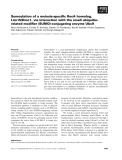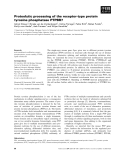
Types of translation
-
This study aims to investigate the language used for denoting graduation in English literary discourse. Basing on the theoretical framework of Appraisal proposed by Martin and White (2005), it lays its focus particularly on how intensification as graduation is realized via linguistic and stylistic means in English literary discourse. A comparison among expressions for intensification is established to recognize what sub-groups are preferable to be used in this type of discourse.
 250p
250p  linyanjun_2408
linyanjun_2408
 21-04-2022
21-04-2022
 29
29
 2
2
 Download
Download
-
The major aim of the research is to identify the domestication and foreignization of culture-specific items appears in the novel for children. To compare and contrast the phenomenon in the two works done by two different translators to figure out the way they deal with culture-specific items using the strategies, which, together with other and further research, contributes to the enablement of the suggested approaches to translating culture-specific items as for the type of literature for children.
 128p
128p  closefriend09
closefriend09
 16-11-2021
16-11-2021
 22
22
 5
5
 Download
Download
-
An overview of the frequently seen types of mistakes in English - Vietnamese translation on tourism terms that may make their translations unnatural and incomprehensible so that they are fully aware of and able to avoid them. Finding causes of translation unnaturalness and then suggesting some possible strategies to overcome the problems.
 73p
73p  trinhthamhodang1217
trinhthamhodang1217
 07-01-2021
07-01-2021
 57
57
 5
5
 Download
Download
-
Transglutaminase (TGase) catalyses the post-translational modification of proteins by transamidation of available glutamine residues. While several TGase genes of fish and arthropods have been cloned and appear to have similar structures to those of mammals, no homologous gene has been found in lower eukaryotes. We have cloned the acellular slime mold Physarum polycephalum TGase cDNA using RT-PCR with degenerated primers, based on the partial amino acid sequence of the purified enzyme. The cDNA contained a 2565-bp ORF encoding a 855-residue polypeptide.
 10p
10p  research12
research12
 01-06-2013
01-06-2013
 48
48
 4
4
 Download
Download
-
The structure of post-translational modifications of human heparin cofactor II isolated from human serum and from recombinant Chinese hamster ovary cells and their effects on heparin binding have been characterized. Oligosaccharide chains were found attached to all three potential N-glycosylation sites in both protein preparations. The carbohydrate structures of heparin cofactor II circulating in blood are complex-type diantennary and triantennary chains in a ratio of 6 : 1 with the galactose being 90% sialylated with a2 fi 6 linked N-acetylneuraminic acid....
 12p
12p  research12
research12
 01-06-2013
01-06-2013
 44
44
 3
3
 Download
Download
-
In the past, we presented tutorials called “Introduction to Statistical Machine Translation”, aimed at people who know little or nothing about the field and want to get acquainted with the basic concepts. This tutorial, by contrast, goes more deeply into selected topics of intense current interest. We aim at two types of participants: 1. People who understand the basic idea of statistical machine translation and want to get a survey of hot-topic current research, in terms that they can understand. 2.
 1p
1p  hongphan_1
hongphan_1
 15-04-2013
15-04-2013
 64
64
 3
3
 Download
Download
-
We developed caitra, a novel tool that aids human translators by (a) making suggestions for sentence completion in an interactive machine translation setting, (b) providing alternative word and phrase translations, and (c) allowing them to postedit machine translation output. The tool uses the Moses decoder, is implemented in Ruby on Rails and C++ and delivered over the web. We are at the beginning of a research program to explore the benefits of these different types of aid to human translators, analyze user interaction behavior, and develop novel types of assistance. ...
 4p
4p  hongphan_1
hongphan_1
 15-04-2013
15-04-2013
 61
61
 2
2
 Download
Download
-
Trypanosoma cruzi, the parasitic protozoan that causes Chagas disease, contains a major cysteine proteinase, cruzipain. This lysosomal enzyme bears an unusual C-terminal extension that contains a number of post-translational modifications, and most antibodies in natural and experimen-tal infections are directed against it. In this report we took advantage of UV-MALDI-TOF mass spectrometry in conjunction with peptide N-gly-cosidase F deglycosylation and high performance anion exchange chroma-tography analysis to address the structure of the N-linked oligosaccharides present in this domain. ...
 13p
13p  fptmusic
fptmusic
 11-04-2013
11-04-2013
 42
42
 2
2
 Download
Download
-
Transglutaminases form a large family of intracellular and extracellular enzymes that catalyse the Ca 2+ -dependent post-translational modification of proteins. Despite significant advances in our understanding of the biolo-gical role of most mammalian transglutaminase isoforms, recent findings suggest new scenarios, most notably for the ubiquitous tissue transglutami-nase.
 17p
17p  awards
awards
 05-04-2013
05-04-2013
 43
43
 3
3
 Download
Download
-
Membrane-associated calcium-independent phospholipase A2c(iPLA2c) contains four potential in-frame methionine start sites (Mancuso, D.J. Jenkins, C.M. & Gross, R.W. (2000)J. Biol. Chem.275, 9937–9945), but the mechanisms regulating the types, amount and subcellular localization of iPLA2c in cells are incompletely understood.
 16p
16p  awards
awards
 05-04-2013
05-04-2013
 55
55
 3
3
 Download
Download
-
The catalytic module ofHypocrea jecorina(previously Trichoderma reesei) Cel7B was homologously expressed by transformation of strain QM9414. Post-translational modi-fications in purified Cel7B preparations were analysed by enzymatic digestions, high performance chromatography, mass spectrometry and site-directed mutagenesis. Of the five potential sites found in the wild-type enzyme, only Asn56 and Asn182 were found to be N-glycosylated.
 11p
11p  dell39
dell39
 03-04-2013
03-04-2013
 44
44
 5
5
 Download
Download
-
Sumoylation is a post-translational modification system that covalently attaches the small ubiquitin-related modifier (SUMO) to target proteins. Ubc9 is required as the E2-type enzyme for SUMO-1 conjugation to tar-gets. Here, we show that Ubc9 interacts with the meiosis-specific RecA homolog, Lim15⁄Dmc1 in the basidiomyceteCoprinus cinereus(CcLim15), and mediates sumoylation of CcLim15 during meiosis.
 10p
10p  inspiron33
inspiron33
 25-03-2013
25-03-2013
 39
39
 5
5
 Download
Download
-
Plumbago indicaL. contains naphthoquinones that are derived from six acetate units. To characterize the enzyme catalyzing the first step in the biosynthesis of these metabolites, a cDNA encoding a type III polyketide synthase (PKS) was isolated from roots of P. indica. The translated poly-peptide shared 47–60% identical residues with PKSs from other plant spe-cies.
 12p
12p  inspiron33
inspiron33
 23-03-2013
23-03-2013
 31
31
 4
4
 Download
Download
-
The single-copy mouse genePtprrgives rise to different protein tyrosine phosphatase (PTP) isoforms in neuronal cells through the use of distinct promoters, alternative splicing, and multiple translation initiation sites. Here, we examined the array of post-translational modifications imposed on the PTPRR protein isoforms PTPBR7, PTP-SL, PTPPBSc42 and PTPPBSc37, which have distinct N-terminal segments and localize to dif-ferent parts of the cell.
 13p
13p  inspiron33
inspiron33
 23-03-2013
23-03-2013
 37
37
 4
4
 Download
Download
-
Protein glycation by methylglyoxal is a nonenzymatic post-translational modification whereby arginine and lysine side chains form a chemically heterogeneous group of advanced glycation end-products. Methylglyoxal-derived advanced glycation end-products are involved in pathologies such as diabetes and neurodegenerative diseases of the amyloid type.
 15p
15p  inspiron33
inspiron33
 23-03-2013
23-03-2013
 51
51
 4
4
 Download
Download
-
LeIF, aLeishmaniaprotein similar to the eukaryotic initiation factor eIF4A, which is a prototype of the DEAD box protein family, was origin-ally described as a Th1-type natural adjuvant and as an antigen that indu-ces an IL12-mediated Th1 response in the peripheral blood mononuclear cells of leishmaniasis patients.
 15p
15p  inspiron33
inspiron33
 23-03-2013
23-03-2013
 32
32
 3
3
 Download
Download
-
Recent studies suggest that diverse types of intronic and small non-coding RNAs play pivotal regulatory roles, often as a part of ribonucleoprotein (RNP) complexes, in a variety of cellular proces-ses such as transcription and translation. Thus, isolation and char-acterization of novel RNP complexes, such as micro RNPs, small nuclear RNPs, small nucleolar RNPs, and heteronuclear RNPs, are crucial to understand the biological systems.
 20p
20p  galaxyss3
galaxyss3
 19-03-2013
19-03-2013
 44
44
 2
2
 Download
Download
-
Mitochondrial cytochromescandc1 are present in all eukaryotes that use oxygen as the terminal electron acceptor in the respiratory chain. Matura-tion of c-type cytochromes requires covalent attachment of the heme cofac-tor to the protein, and there are at least five distinct biogenesis systems that catalyze this post-translational modification in different organisms and organelles.
 18p
18p  media19
media19
 06-03-2013
06-03-2013
 39
39
 4
4
 Download
Download
-
Type 2A serine⁄threonine phosphatases are part of the PPP subfamily that is formed by PP2A, PP4 and PP6, and participate in a variety of cellular processes including transcription, translation, regulation of the cell cycle, signal transduction and apoptosis.
 14p
14p  media19
media19
 05-03-2013
05-03-2013
 37
37
 3
3
 Download
Download
-
Protein N-myristoylation plays key roles in various cellular functions in eukaryotic organisms. To clarify the relationship between the efficiency of protein N-myristoylation and the amino acid sequence of the substrate in plants, we have applied a wheat germ cell-free translation system with high protein productivity to examine the N-myristoylation of various wild-type and mutant forms ofArabidopsis thalianaproteins.
 12p
12p  viettel02
viettel02
 19-02-2013
19-02-2013
 76
76
 4
4
 Download
Download
CHỦ ĐỀ BẠN MUỐN TÌM

































